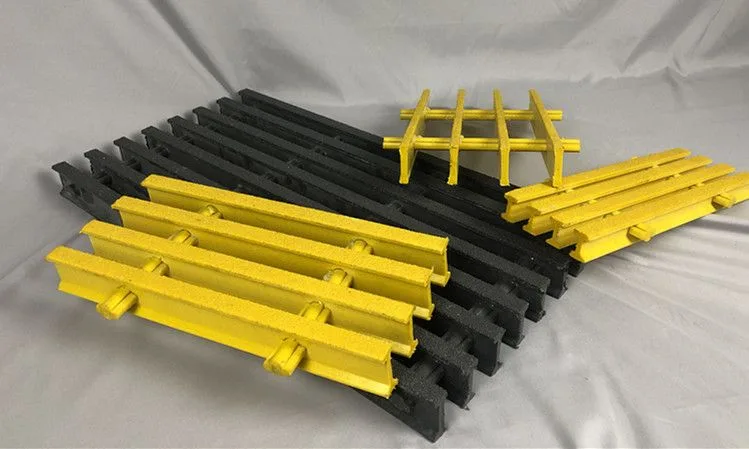Introduction
Fiberglass pultruded grating has become a popular choice in industrial applications due to its remarkable durability, versatility, and performance. Unlike traditional materials like steel or aluminum, fiberglass grating offers a range of advantages tailored to meet the demands of harsh and high-stress environments. This article explores five key benefits that make fiberglass pultruded grating an ideal solution for industries worldwide.

fiberglass pultruded grating
What is Fiberglass Pultruded Grating?
Fiberglass pultruded grating is a type of grating made from a combination of fiberglass reinforcements and resin. It is manufactured through a process called pultrusion, where materials are pulled through a heated die to create strong, lightweight profiles. The result is a highly durable product that can withstand extreme conditions while maintaining structural integrity.
Key features include:
- High resistance to corrosion and chemical exposure.
- Lightweight yet strong construction.
- Slip-resistant surfaces for improved safety.
5 Key Benefits of Fiberglass Pultruded Grating
1. Superior Strength-to-Weight Ratio
One of the most notable advantages of fiberglass pultruded grating is its exceptional strength-to-weight ratio. Despite being significantly lighter than traditional materials like steel, it can support heavy loads without bending or breaking. This makes it easier to transport and install while still delivering robust performance.
- Example: In offshore platforms, fiberglass grating is preferred because it offers strength comparable to steel without adding excessive weight, reducing structural stress.
2. Corrosion Resistance
Fiberglass pultruded grating is designed to resist damage from chemicals, moisture, and other corrosive agents. Unlike steel, which can rust over time, fiberglass grating retains its integrity even in harsh environments.
- Ideal Applications: Chemical plants, marine docks, wastewater treatment facilities.
- Benefit: Lower long-term costs due to reduced maintenance and replacement needs.
3. Low Maintenance Requirements
Industries value materials that require minimal upkeep, and fiberglass pultruded grating excels in this area. Its durable construction resists wear and tear, reducing the need for frequent repairs or replacements. Furthermore, it does not require special coatings or treatments to maintain its functionality.
- Cost Savings: By minimizing maintenance efforts, companies save on labor and material expenses over the lifespan of the product.
4. Enhanced Safety Features
Safety is a top priority in industrial environments, and fiberglass pultruded grating is engineered with features that enhance workplace safety:
- Slip Resistance: Textured surfaces prevent slips and falls, even in wet or oily conditions.
- Non-Conductivity: Unlike metal, fiberglass does not conduct electricity, reducing the risk of electrical hazards.
- Fire Resistance: Special resins can be used to meet fire-retardant requirements, adding another layer of protection.
These properties make it a reliable choice for industries like power generation, oil and gas, and transportation.
5. Customization and Versatility
Fiberglass pultruded grating is available in a wide range of sizes, thicknesses, colors, and finishes, allowing for customization to meet specific project requirements. This versatility ensures it can adapt to diverse applications, from drainage covers to mezzanine floors.
- Flexibility: Whether you need a lightweight walkway or a heavy-duty platform, fiberglass grating can be tailored to suit your needs.
Real-World Applications of Fiberglass Pultruded Grating
Fiberglass pultruded grating is utilized in a variety of industries and scenarios, including:
- Marine Environments: Docks, piers, and ship decks where resistance to saltwater corrosion is essential.
- Chemical Processing Plants: Flooring and platforms that withstand exposure to harsh chemicals.
- Wastewater Treatment Facilities: Covers and walkways that endure moisture and chemical exposure.
- Manufacturing Facilities: Industrial flooring that ensures safety and durability.
How to Choose the Right Fiberglass Pultruded Grating
Selecting the right grating depends on several factors:
- Load Capacity: Ensure the grating can support the expected load.
- Environmental Conditions: Choose materials and resins suitable for exposure to chemicals, moisture, or UV light.
- Application Needs: Consider factors like slip resistance, fire resistance, and size requirements.
Conclusion
Fiberglass pultruded grating offers unparalleled benefits, from its lightweight strength to its corrosion resistance and low maintenance requirements. Its enhanced safety features and adaptability make it a valuable choice for industrial applications. By leveraging these advantages, industries can improve operational efficiency while reducing long-term costs.
Ready to explore the possibilities of fiberglass pultruded grating for your project? Contact a trusted supplier today and discover the perfect solution for your needs!
 info@unicomposite.com
info@unicomposite.com


























